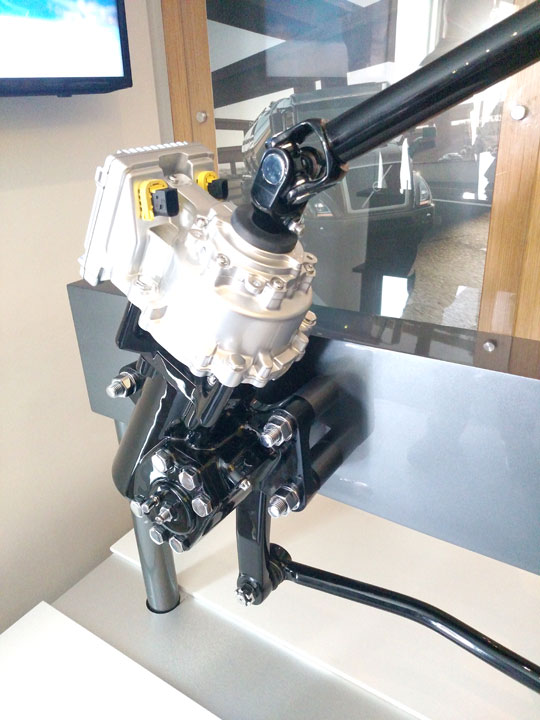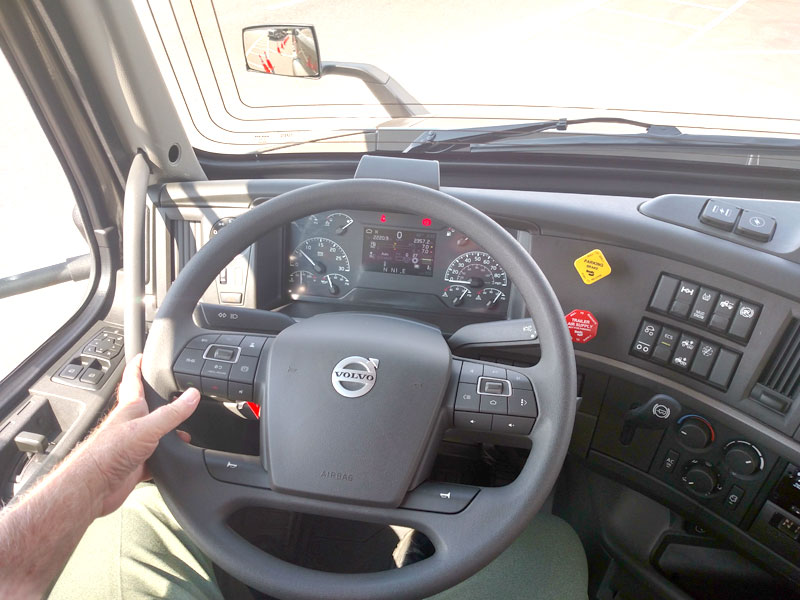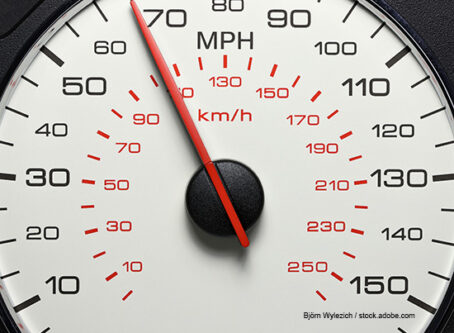Volvo Dynamic Steering cuts driver effort, fatigue
DUBLIN, Va. – Volvo Dynamic Steering, an electric-over-hydraulic system that claims to reduce steering force up to 85%, is coming to North America, the builder announced Sept. 12.
The steering assist greatly cuts driver effort while stabilizing the vehicle in crosswinds and on crowned and uneven pavement. It also helps maintain control in a front-tire blowout and automatically returns the wheel to center during slow-speed maneuvering, officials said at a media event at the New River Valley assembly.
Used in Europe since 2013, the system has been adapted to North American steering gear and axles, said Chris Stadler, a Volvo Trucks’ product marketing manager. The system helps reduce driver fatigue and increase road safety, he said.
Volvo Dynamic Steering, or VDS, will be an option in Volvo VNL and VNR models in early 2020.
“Drivers are the trucking industry’s biggest assets, and opportunities to increase driver recruitment and retention are top-of-mind for our customers,” Stadler said. “Providing state-of-the-art features that improve drivers’ physical working conditions and comfort is an important aspect of driver satisfaction, as well as increasing overall productivity and road safety.”
VDS is an active device with an electric motor mounted on top of the hydraulic steering gear. Input from multiple vehicle sensors, at over 2,000 times per second, determine the appropriate steering wheel response. The system continuously monitors driver actions, environmental factors and road conditions literally faster than the blink of an eye, he said.

The motor provides additional torque when needed to keep the truck safely on the road. This supports driver reactions with greater control and smoother maneuvering. In a failure of sensors or electrical circuitry, it reverts to all-hydraulic operation, Stadler explained.
Adjusts to changing terrains
First launched by Volvo Trucks in Europe, VDS is ideal for diverse and changing terrains and automatically adjusts to handle any roadway condition. From rough roads to tight maneuvers in urban environments, VDS can help drivers navigate unexpected situations such as potholes and rapid tire deflations, adding up to 9 foot-pounds of torque in the steering column.
Key VDS features include:
- Vehicle stability control leads to increased directional stability on the highway, which offers a more relaxed and safe driving experience with full control at all speeds.
- Return-to-center swings the steering wheel to the “neutral” position when the vehicle is in motion, making it easier to reverse the vehicle and maneuver in tight areas.
- Dampening filters relay information from the road surface and, based on feedback from multiple sensors, helps improve handling and vehicle stability.
- Lead/pull compensation provides a torque offset within the steering system to compensate for crowned roads, steady crosswinds and other short-term conditions that can affect handling.
With more controlled steering, VDS helps reduce operational fatigue by filtering road vibration and noise through the steering wheel, and reducing repetitive motions, Stadler said. Testing has shown that VDS has the potential to cut muscular strain by up to 30% and for some specific motions, strain can be reduced up to 70%.
“Volvo Trucks’ new feature brings value and support to our customers and professional drivers,” said Stadler. “With the VDS system, we see increased productivity for our customers and decreased fatigue for drivers. In addition, it contributes to improved stability and control of the vehicle, thereby increasing road safety.”

Driving VDS: noticeably easier
Demonstration runs on a track at Volvo’s customer center adjacent to the factory showed this reporter that noticeably less effort was needed to manipulate a steering wheel, and that turns were smoother with less vertical movement by a truck’s front suspension. Backing a tractor-trailer was also smoother, and the return-to-center function happened with no driver input.
An intentional turn into and out of a shallow, concrete-lined roadside ditch took some effort with standard power steering, but was considerably easier with VDS engaged. We suffered no blown front tires, but here’s a tip if it ever happens to you: Immediately stomp on the accelerator to keep the truck moving, and you’ll easily control things until it’s safe to pull over and stop. I did it in a demo years ago with a big ol’ KW with manual steering, and it works – with a truck or car.
Back to VDS: It was especially helpful at low speeds and while maneuvering in forward or reverse. The amount of assist is adjusted in four increments – 0 to 15 mph, 15 to 30 mph, 30 to 45 and 45 and up. The faster the road speed, the less the electric assist. At highway speeds – not possible on the short oval track with its sharp turns – steering feel is similar to standard hydraulic power steering, our driver guides said.
Dynamic Steering complements Volvo road tractors’ existing limo-like ride and overall smooth operation, especially when a highly capable I-Shift automated manual transmission is part of the powertrain, it seems to me. But one claimed benefit, that it cuts shock transmitted through the steering wheel, was less meaningful to me because over the years I’ve learned to loosen my grip in the wheel rim while going over bumps and rough pavement.
Bottom line: I could get along without Dynamic Steering if I cruised on the interstate highways all day. But for local or regional duties, where tight turning and up-and-back movements are involved, I’d want it. That depends on what it’ll cost, and at this event officials declined to state a price.









